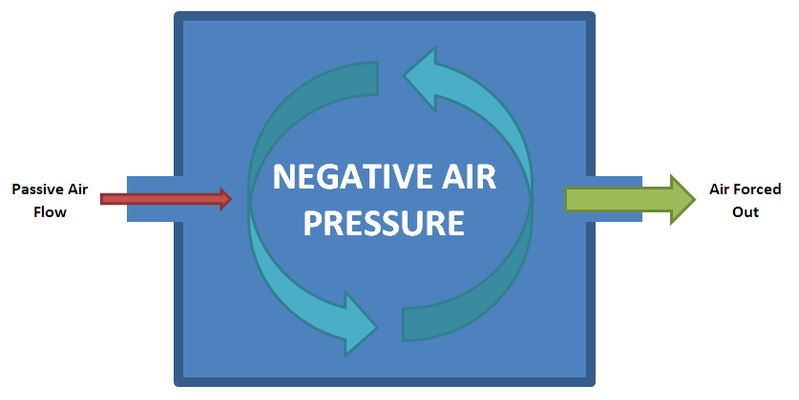When designing an industrial ventilation system, an important design criterion is determining whether the facility requires a positive or negative pressure environment to protect people, products, and processes. In this week’s blog I’ll discuss the benefits of both, the factors that should be considered, and how the ventilation equipment should be sized to achieve the desired positive or negative pressure.
Negative Pressure
 A negative pressure environment is created by using fans for exhaust air and louvers or doors for supply air. When the exhaust fans are on, they create a vacuum in the building which pulls air in through the supply air openings. The amount of negative pressure created in the building depends on the air flow resistance created by the supply openings. Too much negative pressure may cause man doors to slam open or closed creating a risk for injury if fingers are caught in the door.
A negative pressure environment is created by using fans for exhaust air and louvers or doors for supply air. When the exhaust fans are on, they create a vacuum in the building which pulls air in through the supply air openings. The amount of negative pressure created in the building depends on the air flow resistance created by the supply openings. Too much negative pressure may cause man doors to slam open or closed creating a risk for injury if fingers are caught in the door.
When louvers are used in the supply air openings, the amount of open area in the louver should be sized to keep the air velocity at the face of the louver below a level that causes a dangerous amount of negative pressure. Most manufacturers provide charts that will show the pressure drop relative to the face velocity for their louvers.
When man or truck doors are intended to be the primary source of supply air, then there should be an operating policy that requires one or more of the doors to be open when the exhaust fans are running. If all doors are closed, then a potentially dangerous negative pressure level could develop. One way to avoid a dangerous pressure level is to have a backdraft damper installed in the space that will relieve the pressure when all doors are closed.
A negative pressure ventilation system has two benefits. The first is that the location of the exhaust air can be controlled. This is important when there are heat, fumes or dust generating sources inside the building. Locating the exhaust fans in the right spot can pull the heat and contaminants away from people, products, or processes. The second benefit is that a negative pressure system will keep the heat and contaminants from infiltrating adjoining locker rooms, break rooms or offices.
One downside to a negative pressure system is that the location of supply air can’t be absolutely controlled. While it may be the intention for the supply air to come in through louvers or doors, the reality is that the air will also come in through other openings or cracks in the building. Because air will follow the path of least resistance, if there are other openings or cracks too close to the exhaust fan, the air will short circuit from the opening to the fan without providing any benefit. Another downside to negative pressure systems is they will bring in outside dust and contaminants into the building because the system is basically pulling from outside into the building.
 Positive Pressure
Positive Pressure
A positive pressure environment is created by using fans for supply air and louvers or doors for exhaust air. When the supply fans are on, they will have an effect on the building like blowing up a balloon. The same issues apply regarding using louvers and doors for exhaust air in a positive pressure environment as they do to providing supply air in a negative pressure environment. When there is too much resistance to the exhaust air flow, a potentially dangerous level of positive pressure can build causing man doors to slam open or closed. Use the same process for sizing louvers and keeping doors open in a positive pressure environment.
The primary benefit of a positive pressure environment is that the location of the supply air can be controlled to prevent infiltration of air borne contaminates. Instead of air flowing in through other openings and cracks in the building, the positive pressure will push air out and prevent outside contaminates from affecting people, products, and processes. To do that most effectively, the supply air fan must have a filter. The size and efficiency of the filters required for the application will depend on the smallest sized particle that needs to be filtered out. Therefore, the biggest downside to a positive pressure environment is the upfront cost of the filter housings and the annual cost of replacing filters.
Conclusion
A good rule of thumb to determine when to use either a positive or negative pressure ventilation system for an industrial application is the location of sources of heat or air borne contaminates that could affect people, products, or processes. If these sources are inside the building, then a negative pressure system works best to control the exhaust of the heat or air borne contaminates by providing exhaust ventilation in the area where they are located. If the sources are outside of the building, then a positive pressure system will minimize the potential infiltration of air borne contaminates as long as filters are added to the supply fans. If you need help configuring a positive or negative pressure environment for your facility, contact an Eldridge ventilation expert.
